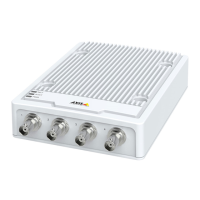
Do you have a question about the Axis M7104 and is the answer not in the manual?
| PAL resolutions | 720x576 pixels |
|---|---|
| NTSC resolutions | 720x480 pixels |
| Channels quantity | 4 channels |
| Maximum frame rate | 30 fps |
| Maximum video resolution | 720 x 576 pixels |
| Video compression formats | AVC, H.264, H.265, HEVC, MPEG4 |
| PTZ control | Yes |
| Flash memory | 512 MB |
| Image settings | Brightness, Color, Compression, Contrast, Mirroring, Privacy mask, Rotation, Sharpness |
| Internal memory | 1024 MB |
| Compatible memory cards | MicroSD (TransFlash), MicroSDHC, MicroSDXC |
| Networking standards | IEEE 802.3af, IEEE 802.3at |
| Supported network protocols | IPv4, IPv6 USGv6, HTTP, HTTPS, SSL/TLS, QoS Layer 3 DiffServ, FTP, SFTP, CIFS/SMB, SMTP, Bonjour, UPnP , SNMP v1/v2c/v3 (MIB-II), DNS, DynDNS, NTP, RTSP, RTP, SRTP, TCP, UDP, IGMP, RTCP, ICMP, DHCP, ARP, SOCKS, SSH |
| Copper ethernet cabling technology | 10BASE-T, 100BASE-T, 1000BASE-T |
| Security algorithms | HTTPS |
| Certification | 55032 Class A, EN 61000-3-2, EN 61000-3-3, EN 55024, EN 61000-6-1, EN 61000-6-2, FCC Part 15 Subpart B Class A, ICES-003 Class A, VCCI Class A, RCM AS/NZS CISPR 32 Class A, KC KN32 Class A, KC KN35, IEC/EN 62368-1, 55032 Class A, EN 61000-3-2, EN 61000-3-3, EN 55024, EN 61000-6-1, EN 61000-6-2, FCC Part 15 Subpart B Class A, ICES-003 Class A, IEC 60068-2-1, IEC 60068-2-2, IEC 60068-2-6, IEC 60068-2-14, IEC 60068-2-27, IEC 60068-2-78VCCI Class A, RCM AS/NZS CISPR 32 Class A, KC KN32 Class A, KC KN35, NIST SP500-267 |
| Product color | White |
| LED indicators | Status |
| Power consumption (typical) | 4.7 W |
| Storage temperature (T-T) | -40 - 65 °C |
| Operating temperature (T-T) | 0 - 50 °C |
| Operating relative humidity (H-H) | 10 - 85 % |
| RS-485 ports | 2 |
| BNC input ports | 4 |
| I/O terminal ports | - |
| Ethernet LAN (RJ-45) ports | 1 |
| Width | 187 mm |
|---|---|
| Height | 37 mm |
| Weight | 650 g |
Procedure to ensure the device has original Axis firmware and security.
Guidance on setting a secure password for the administrator account.
Recommendations for creating and maintaining strong, secure passwords for the device.
Steps to configure network storage for saving recordings.
Guide to creating rules for device actions triggered by events like motion detection.
Details on setting up rules to trigger specific actions based on conditions.
How to configure email notifications for tampering events like lens obstruction.
Procedure for restoring the device to its original factory default configuration.
Guidance on the process and considerations for updating the device firmware.
Troubleshooting steps for common issues encountered during firmware upgrades.
Guidance for resolving issues related to setting or accessing the device's IP address.
Resolving IP address conflicts that occur within the same network subnet.
Solutions for issues preventing browser access to the device.
Troubleshooting steps for login failures, including lost root passwords.
How to locate the device when its IP address is dynamically changed by DHCP.